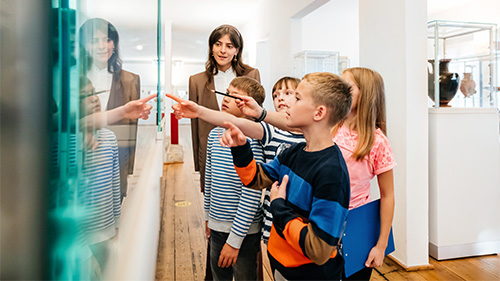6 Unique Exit Tickets to Use with Your Students
An exit ticket can be an effective way to determine if students are understanding what they are being taught. They provide immediate feedback, while...
AP & Honors Mathematics
Explore Wiley titles to support both AP and Honors mathematics instruction.
Literacy Skills & Intensive Reading
Connections: Reading – Grades 6–12
Empower student success with a proven intensive reading program that develops strong reading skills in striving readers.
Drama, Speech & Debate
Basic Drama Projects 10th Edition
Build students’ confidence and competence with comprehensive, project-based theatre instruction.
Literature
Connections: Literature
Support learners as they study dynamic, relevant texts and bring the richness of diverse voices to students through literature.
Literature & Thought
Develop critical thinking, reading, and writing across literacy themes, genres, historical eras, and current events.
Language Arts
Vocabu-Lit® – Grades 6–12
Help students build word power using high-quality contemporary and classic literature, nonfiction, essays, and more.
Connections: Writing & Language
Help students develop grammar, usage, mechanics, vocabulary, spelling, and writing and editing skills.
Reading/English Language Arts
Measuring Up to the English Language Arts Standards
Incorporate standards-driven teaching strategies to complement your ELA curriculum.
English Language Learners
Measuring Up for English Language Learners
Incorporate research-based best practices for ELLs with an approach that includes a focus on language acquisition strategies.
Mathematics
Measuring Up to the Mathematics Standards
Incorporate standards-driven teaching strategies to complement your mathematics curriculum.
Foundations
Measuring Up Foundations
Help students master foundational math skills that are critical for students to find academic success.
Science
Measuring Up to the Next Generation Science Standards
Give students comprehensive NGSS coverage while targeting instruction and providing rigorous standards practice.
Assessment
Measuring Up Live
Deliver innovative assessment and practice technology designed to offer data-driven instructional support.
For a better website experience, please confirm you are in:
ELPs provide them with a fun learning environment and create a sense of belonging. These learning programs are also a productive way to support learning.
ELPs engage students and boost achievement. Researchers found that ELPs “had positive and significant effects among students at risk for failure in reading or math.”1 Successful schools are seeing positive results when their ELPs align to standards and directly support classroom instruction. However, crafting a program that supports classroom instruction without redundancy can be tricky.
One way to provide congruency with classroom instruction is to maintain a focus on grade-level standards, but in a different way. One key study found that successful ELPs were not merely an extension of the school day, but a chance to expand upon what students were learning.2 Using resources that are congruent with classroom instruction is an effective way to reinforce rigors of standards-based instruction in a low-risk environment. Although ELPs focus on skills and standards students need, they look and feel different to students. But make sure the programs are teachable. ELPs should be easy to use and effective. Look for resources that are organized by standards and that have a consistent instructional design with ample teacher support to guide implementation.
Creating a balance between academics and fun is also important. One way to boost the “fun factor” is to create a reward system for academic success that allows students to choose a non-academic reward.
Finally, communication between extended-learning staff and students is important. After all, it is the teacher who is recommending students for ELP, so it is critical to keep the lines of communication open.
Conclusion
ELPs share the same goal as the classroom but should use totally different styles to keep students engaged. With an eye on academic achievement, creating a risk-free, fun learning environment is a welcome asset into struggling students’ world.
References
(1)Lauer, P. A., Akiba, M., Wilkerson, S. B., Apthorp, H. S., Snow, D., & Martin-Glenn, M. L. (2006). Out-of-School-Time Programs: A Meta-Analysis of Effects for At-Risk Students. Review of Educational Research, Vol. 76, No. 2 (Summer, 2006), pp. 275-313. American Educational Research Association. 3. Vandell, D. L., Reisner, E. R., & Pierce, K. M. Quoted in What does the research say about afterschool programs. November 2017. The Afterschool Alliance. Retrieved from http://afterschoolalliance.org/documents/what_does_the_research_say_about_afterschool.pdf
(2)McCutcheon, Emily R., Hadjiharalambous, Sissie. (2016) Profiles of Extended Learning Programs: Promising Practices in Tennessee’s 21st Century Community Learning Center. Retrieved from https://www.tn.gov/content/dam/tn/education/documents/ext_learning_promising_practices_profiles.pdf

An exit ticket can be an effective way to determine if students are understanding what they are being taught. They provide immediate feedback, while...

Summer is almost here. For many, it’s a time to relax and leave schoolwork worries behind. However, by the time school starts up again in the fall,...

Educational studies have proven time and time again that learning loss is a real phenomenon.

Having a comprehensive and well-designed curriculum at your fingertips will go a long way toward creating summer enrichment activities that engage...

December is a unique month in the classroom. Energy is high, schedules are unpredictable, and instructional time can feel fragmented. But it’s also...

As winter break approaches, classrooms across the country buzz with excitement—and a fair amount of distraction. December is a notoriously tricky...

Every spring, standardized testing can feel like a looming mountain for both students and teachers. The challenge is real: how do we prepare students...

With so much heated debate over the concept of teaching to the test, it almost seems counterintuitive to ask teachers to assess their students even...

We’ve heard of Project-Based Learning (PBLs), which allows students to mostly have independent leadership through a task or project and creative...

Discover how simulations can enhance learning in AP® U.S. Government and Politics. Engage students with hands-on activities like discretionary...

